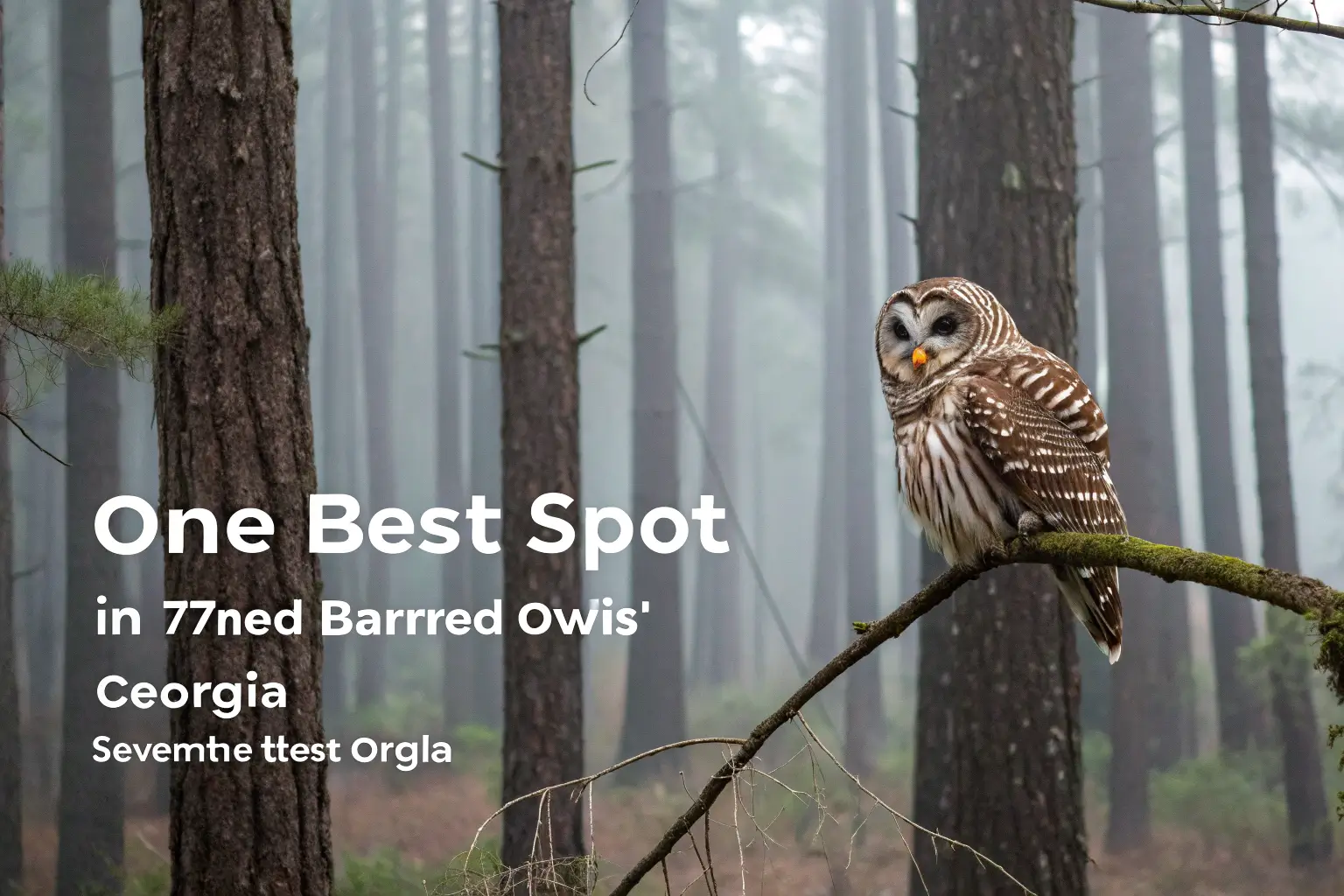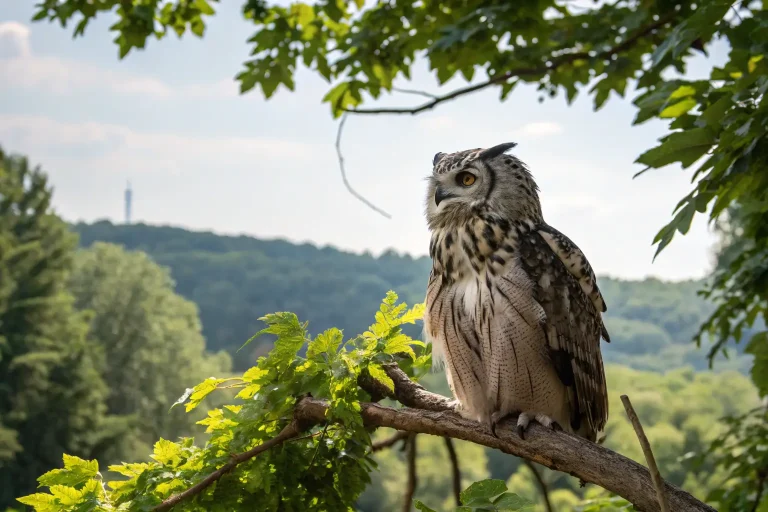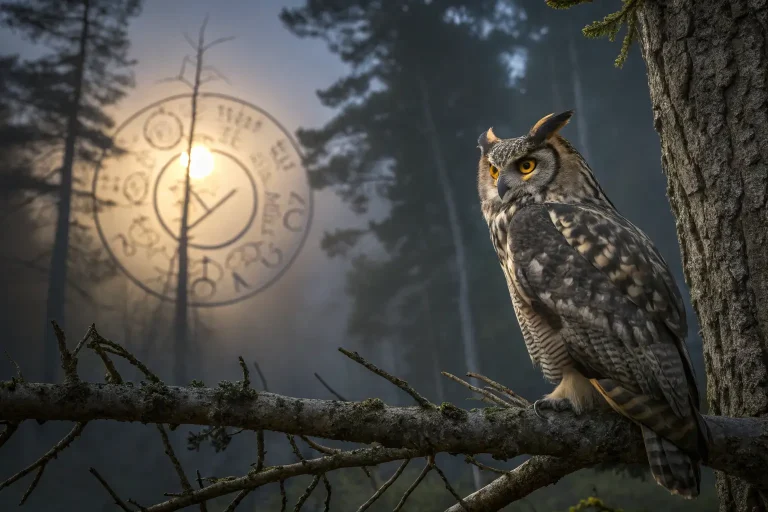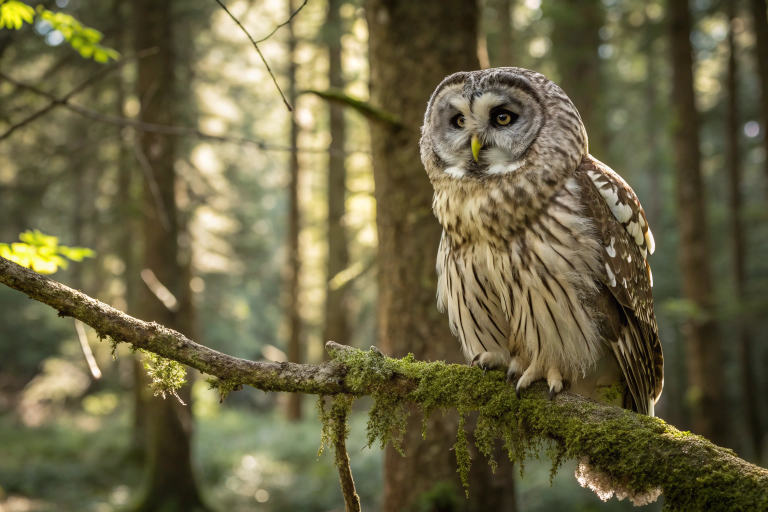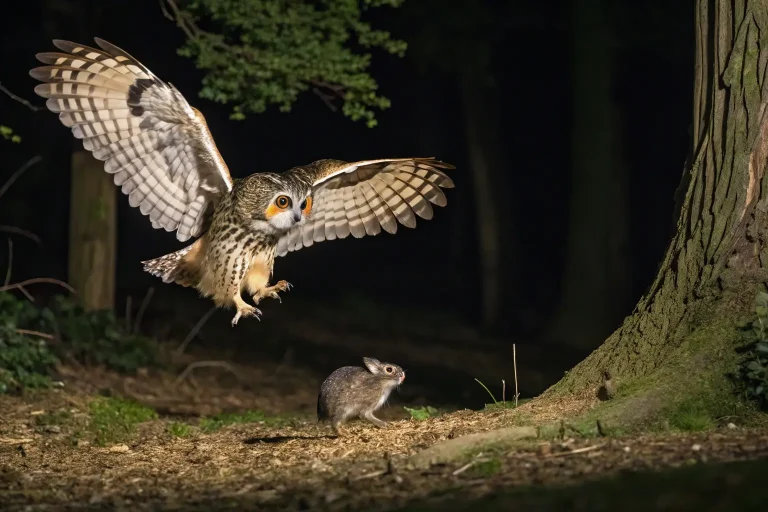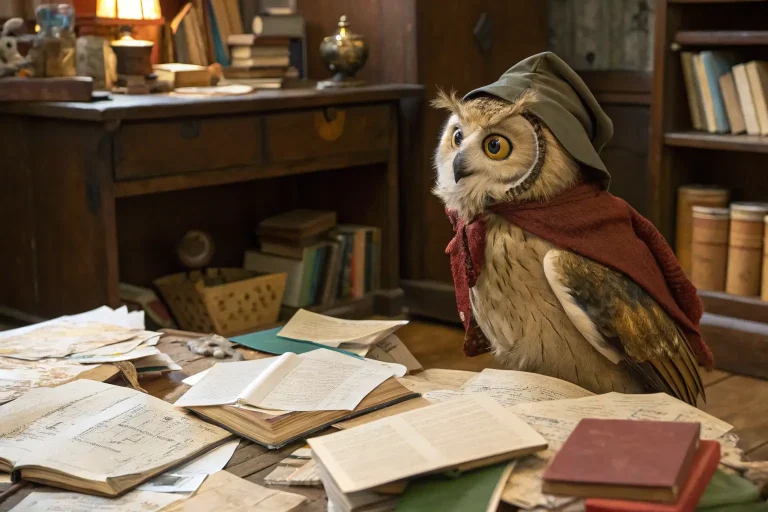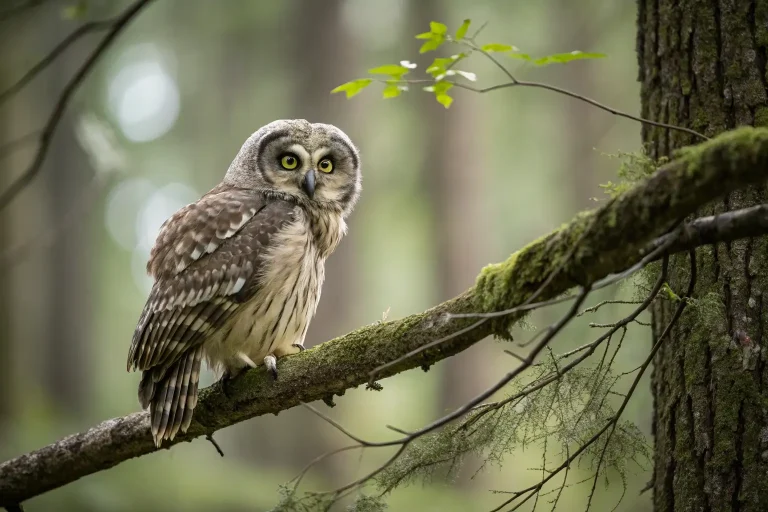How to Spot the Barred Owls in Georgia: 7 Best Locations Revealed
Searching for the elusive barred owls in Georgia? These magnificent birds with their distinctive “who-cooks-for-you” hoots can be found throughout Georgia’s diverse forests and wetlands, but knowing exactly where are the barred owls in Georgia can transform a casual nature walk into an unforgettable wildlife encounter. This comprehensive guide reveals seven prime locations where barred owls regularly make their homes across the Peach State, along with expert tips to maximize your chances of spotting these charismatic raptors in their natural habitat.
Introduction
The barred owl (Strix varia) represents one of Georgia’s most charismatic and vocal woodland residents. With their soulful dark eyes and distinctive hooting calls that echo through forests at dusk, these magnificent birds captivate both casual observers and dedicated birders alike. Finding where are the barred owls in Georgia has become increasingly popular as more people seek meaningful connections with Georgia’s wildlife.
Understanding these remarkable creatures not only enriches your outdoor experiences but also contributes to conservation awareness. Barred owls serve as indicators of forest health—their presence typically signals a balanced ecosystem with ample prey populations and suitable nesting habitat. By learning where barred owls in Georgia tend to congregate, you’ll gain insight into the state’s most pristine natural areas.
Did you know that despite their impressive size (16-25 inches tall with a wingspan reaching 44 inches), barred owls remain surprisingly elusive? Unlike many birds that migrate seasonally, barred owls maintain year-round territories in Georgia, making them one of the few owl species you can reliably find in the same locations throughout all four seasons.
Species Overview
Scientific Name: Strix varia
The barred owl belongs to the genus Strix, which includes about 15 species of wood owls distributed worldwide. The species name “varia” refers to the varied pattern of barring on their plumage.
Physical Characteristics
Barred owls in Georgia display the classic features that make them instantly recognizable among the state’s bird population. These medium-large owls stand 16-25 inches tall and weigh between 1-2.5 pounds, with females typically larger than males—a common trait among raptors. Their wingspan extends an impressive 38-44 inches, allowing for silent, effortless flight through dense forest canopies.
Their most distinctive feature is the beautiful brown and white barring pattern that covers their chest (running horizontally) and belly (running vertically), creating a “barred” appearance that gives them their name. Unlike the great horned owl, barred owls lack ear tufts, instead featuring a round, smooth head with a facial disk that frames their deep brown, almost black eyes. This face pattern, combined with their dark eyes (most owls have yellow eyes), gives them an inquisitive, somewhat melancholic expression that many observers find particularly appealing.
Their plumage consists predominantly of brown and white coloration that provides excellent camouflage when perched against tree bark. In flight, the barred owl displays broad, rounded wings typical of forest-dwelling owls that need to maneuver through tight spaces.
Subspecies
While no official subspecies of barred owls exist in Georgia specifically, these owls do exhibit subtle variations in their coloration and size across their range. Georgia’s barred owls represent the southeastern population, which tends to have slightly warmer brown tones compared to their northern counterparts. This regional variation helps them blend perfectly with the specific tree species and lighting conditions found in Georgia’s diverse forest ecosystems.
Habitat and Distribution
Natural Habitat
Understanding where are the barred owls in Georgia requires knowledge of their preferred habitats. These adaptable birds strongly favor mature, mixed forests with large deciduous and coniferous trees that provide suitable nesting cavities. Unlike some owl species that prefer open landscapes, barred owls thrive in dense woodland settings, particularly those adjacent to water sources like rivers, swamps, and marshes.
Their ideal habitat features a combination of:
- Mature trees (especially oak, hickory, and pine)
- Abundant natural cavities or abandoned hawk/crow nests
- Proximity to water bodies
- Dense understory for daytime roosting
- Open areas within forests for hunting
This habitat preference explains why barred owls in Georgia concentrate in the state’s river bottoms, swamps, and mixed hardwood forests rather than purely pine plantations or heavily developed areas.
Geographic Range
Barred owls enjoy a widespread distribution throughout Georgia, from the coastal plains to the foothills of the Appalachians. They’re most abundant in the central and eastern portions of the state where mature bottomland hardwood forests remain intact. You’ll find barred owls in Georgia’s Piedmont region, especially along major river corridors like the Chattahoochee, Oconee, and Ocmulgee Rivers.
The Coastal Plain and barrier islands also support healthy barred owl populations, particularly in maritime forests and cypress-tupelo swamps. Even Georgia’s urban areas may harbor barred owls where sufficient green space and mature trees exist, as these adaptable birds have shown remarkable tolerance for human proximity when suitable habitat remains available.
Adaptations
Barred owls in Georgia have developed several specialized adaptations that make them perfectly suited to their woodland environment:
- Silent flight: Specialized feather edges that break up air turbulence, allowing for nearly soundless movement when hunting
- Exceptional hearing: Asymmetrical ear openings that pinpoint prey location with remarkable precision even in complete darkness
- Superior night vision: Enormous eyes with rod-heavy retinas that gather available light efficiently
- Rotating head: The ability to turn their head up to 270 degrees, compensating for fixed eye positions
- Climate tolerance: Dense plumage that insulates against both Georgia’s occasional winter chills and humid summer heat
These adaptations explain why barred owls remain year-round residents in Georgia rather than migrating seasonally like many other bird species.
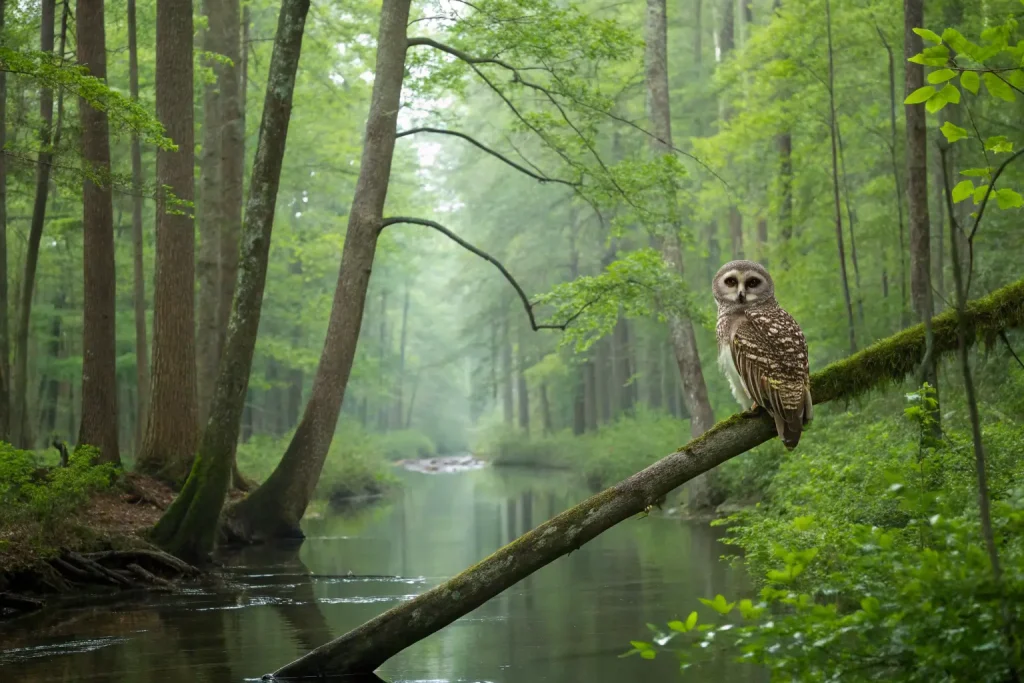
7 Best Locations to Spot Barred Owls in Georgia
Now to the heart of the matter—where are the barred owls in Georgia most reliably found? Based on expert observations, eBird data, and local naturalist reports, these seven locations offer your best chances for encountering these magnificent birds:
1. Chattahoochee River National Recreation Area
This expansive park system following Atlanta’s primary river corridor provides perfect barred owl habitat with its mature riverine forests. The wetland sections near Cochran Shoals and Johnson Ferry units consistently host breeding pairs. Visit around sunset and listen for their distinctive calls echoing across the water. The combination of old-growth trees and abundant water makes this area a reliable hotspot for barred owls in Georgia, particularly during the early spring courtship period when calling activity peaks.
2. Okefenokee National Wildlife Refuge
Georgia’s largest swamp creates an ideal environment for barred owls with its ancient cypress forests and abundant prey. Take the Swamp Island Drive or paddle the water trails at dusk for your best chances at spotting these birds. The refuge’s pristine conditions and minimal light pollution create optimal viewing opportunities, with many visitors reporting daytime sightings as the owls sometimes hunt or rest in visible perches throughout the cypresses.
3. Sweetwater Creek State Park
Just west of Atlanta, this park’s protected watershed harbors numerous barred owl territories along its namesake creek. The Red Trail and the ruins area have produced reliable sightings, especially in late winter when territorial hooting becomes more frequent. The mixed hardwood forests and riparian zones provide ideal hunting grounds, making this one of the most accessible locations to find barred owls in Georgia for residents of the metro Atlanta area.
4. Panola Mountain State Park
This conservation park southeast of Atlanta offers excellent barred owl habitat in its older forest sections. The Alexander Lake area and watershed trails provide prime viewing opportunities, particularly at dawn and dusk when feeding activity increases. Park rangers often know active territories and can direct visitors to recent sighting locations, increasing your chances of success during shorter visits.
5. Phinizy Swamp Nature Park
Located near Augusta, this rehabilitated wetland ecosystem has become a barred owl stronghold. The Floodplain Boardwalk and Butler Creek Trail offer the best viewing potential, with multiple pairs established throughout the preserve. The combination of wetland habitat and adjacent upland forest creates a perfect ecological niche for these adaptable owls, with the boardwalks providing surprisingly intimate viewing opportunities without disturbing the birds.
6. George L. Smith State Park
The blackwater cypress lake at this southeast Georgia park creates perfect conditions for barred owls. Paddlers often encounter them while exploring the submerged forest, where the birds perch prominently on cypress knees and overhanging branches. The park’s remote location means less human disturbance, allowing for more natural behavior observation as the owls hunt fish and amphibians directly from the water’s surface—a spectacular sight for patient observers.
7. Sapelo Island National Estuarine Research Reserve
This barrier island hosts a healthy barred owl population in its maritime forests and marsh edges. Guided tours provide access to prime habitat where these owls have adapted to the island’s unique ecosystem. The isolation of the island population has allowed these barred owls to become especially adapted to coastal conditions, with slightly different vocalizations reported by some researchers compared to mainland populations.
Diet and Feeding Habits
What It Eats
Barred owls in Georgia maintain a remarkably diverse diet, which contributes to their adaptability across various ecosystems. Their primary prey includes:
- Small mammals (mice, voles, shrews, flying squirrels)
- Medium-sized mammals (rabbits, young opossums)
- Birds (particularly nestlings and small to medium-sized species)
- Amphibians (frogs, salamanders)
- Reptiles (small snakes, lizards)
- Fish (particularly in swampy areas)
- Crayfish and large insects
This dietary flexibility allows barred owls to thrive in Georgia’s diverse habitats, adjusting their hunting preferences based on seasonal availability. For instance, during spring frog breeding seasons, amphibians may constitute a significant portion of their diet in wetland-adjacent territories.
Hunting or Foraging Behavior
Barred owls employ several distinct hunting strategies that you might observe if you’re lucky enough to spot one in action:
The most common technique involves perch-hunting—patiently waiting on a strategic branch overlooking open areas like forest clearings, meadows, or water edges. When prey is detected, they swoop down silently, often capturing victims unaware thanks to their specialized feathers that eliminate flight noise.
In wetland environments, barred owls in Georgia sometimes wade in shallow water to capture fish or snatch frogs from the water’s surface—behavior not commonly seen in other owl species. Some observers have even documented barred owls running along the ground to pursue prey, demonstrating their adaptability when hunting opportunities arise.
Unlike some strictly nocturnal owls, barred owls frequently hunt during daylight hours, particularly at dawn and dusk, making them more visible to observers than many other owl species. This crepuscular activity pattern increases your chances of witnessing hunting behavior during typical birdwatching hours.
Dietary Needs
The nutritional requirements of barred owls vary seasonally and according to life stage. During breeding season (February-April in Georgia), females require increased calcium and protein intake to support egg production. Similarly, when feeding nestlings, parent owls must capture significantly more prey to meet the growing owlets’ demands.
An adult barred owl typically consumes 1-2 mice or equivalent prey per day, though this varies with prey availability and seasonal energy demands. Their efficient digestive system processes the nutritional components of prey while forming pellets from indigestible materials (bones, fur, feathers) that are later regurgitated—often providing researchers valuable data about local diet composition.
Behavior and Social Structure
Social Behavior
Barred owls in Georgia maintain a primarily monogamous social structure built around bonded pairs defending established territories. Unlike some bird species that gather in flocks, barred owls remain territorial throughout the year, with dedicated pairs maintaining the same territory for many years when undisturbed.
Territory size varies considerably depending on habitat quality, ranging from roughly 200 acres in prime riverine forests to over 900 acres in less productive habitats. These territories are actively defended against intruding barred owls through vocal displays and, if necessary, physical confrontation. The stability of these territories makes it possible for regular observers to reliably locate specific barred owl pairs in Georgia year after year.
Outside the breeding season, barred owls become somewhat less defensive of territory boundaries, though they still maintain core areas around preferred roosting and hunting sites. Juvenile owls typically disperse from their natal territory in late summer, sometimes traveling considerable distances to establish their own territories—a challenging process that results in high mortality among first-year birds.
Communication
The barred owl’s vocalizations rank among Georgia’s most distinctive and recognizable woodland sounds. Their classic nine-note call phonetically rendered as “who-cooks-for-you, who-cooks-for-you-all” carries over considerable distances, especially in the still evening air. These territorial calls serve multiple purposes:
- Advertising territory boundaries
- Maintaining pair bonds
- Coordinating breeding activities
- Warning potential intruders
Beyond their signature hooting, barred owls produce an astonishing variety of vocalizations including:
- “Monkey calls” – wild, ascending hoots that sound remarkably primate-like
- Bill-snapping during aggressive encounters
- Piercing screams during territorial disputes
- Soft cooing between mates
- Begging calls from juveniles
These diverse vocalizations offer observers important behavioral clues, from identifying mated pairs (through synchronized duetting) to locating family groups (through begging calls of juveniles).
Mating and Reproduction
Barred owls in Georgia typically form lifelong pair bonds, with courtship activities beginning as early as December and intensifying through February. This period features increased calling, mutual preening, and food sharing between potential mates. Established pairs engage in dramatic duetting displays where mates alternate portions of calls in rapid succession.
Nesting occurs primarily in natural tree cavities, though barred owls readily accept large abandoned hawk or crow nests and even artificial nest boxes when suitable. Females typically lay 2-4 eggs, which are incubated for approximately 28-33 days while the male provides food for his mate.
Young owlets remain in the nest for 4-5 weeks before “branching”—a period where they climb onto nearby branches but cannot yet fly competently. Parent owls continue feeding and protecting these fledglings for several months as they gradually develop hunting skills. This extended parental care period explains why barred owls typically raise only one brood annually despite their year-round residency in Georgia.
Conservation Status
Endangerment Level
Fortunately, barred owls maintain a conservation status of “Least Concern” according to the International Union for Conservation of Nature (IUCN) Red List. Their Georgia population appears stable and possibly increasing in some areas where forest maturation creates more suitable habitat. The Georgia Department of Natural Resources classifies barred owls as a Species of Special Concern, recognizing their ecological significance while acknowledging their currently secure population status.
This relative stability contrasts with many other raptor species experiencing significant declines, highlighting the barred owl’s adaptability to certain levels of habitat modification. Their willingness to nest near human development (provided suitable forest patches remain) has allowed them to persist in areas where more sensitive species have disappeared.
Threats
Despite their generally secure status, barred owls in Georgia face several significant challenges:
- Habitat fragmentation: The conversion of continuous forests into isolated patches reduces viable territory size and disrupts movement corridors.
- Loss of large cavity trees: Modern forestry practices often remove dead or decaying trees needed for nesting.
- Vehicle collisions: Barred owls hunting along road corridors suffer significant mortality from traffic.
- Rodenticide poisoning: Secondary poisoning occurs when owls consume prey that has ingested toxic rodent control chemicals.
- Competition with great horned owls: These larger, more aggressive owls can displace barred owls from prime habitat.
Climate change presents an emerging threat through altered precipitation patterns affecting wetland habitats and potential shifts in prey availability. Additionally, severe weather events like hurricanes can destroy nesting trees across large areas, temporarily reducing local breeding success.
Conservation Efforts
Several initiatives support barred owl conservation in Georgia:
The Georgia Department of Natural Resources monitors barred owl populations through breeding bird surveys and targeted monitoring programs. These data collection efforts help identify population trends before they reach critical levels.
Habitat preservation through land trust acquisitions and conservation easements protects critical river corridors and mature forests. Organizations like The Nature Conservancy and Georgia Conservancy have prioritized protection of bottomland hardwood forests that represent prime barred owl habitat.
Public education programs highlight the ecological role of these charismatic birds, fostering appreciation that translates into conservation support. Many of Georgia’s nature centers and state parks feature interpretive programs focused on owls, often using non-releasable educational birds to create powerful emotional connections with visitors.
Interesting Facts
The mysteries surrounding barred owls in Georgia extend beyond their haunting calls and silent flight. Consider these fascinating aspects of their biology and behavior:
Unlike most birds with fixed eyes, barred owls possess three eyelids: an upper lid that closes when they blink downward (opposite of humans), a lower lid that closes during sleep, and a specialized nictitating membrane that slides horizontally across the eye for protection while maintaining visibility.
Barred owls have asymmetrically positioned ear openings—one higher than the other—which creates minute differences in sound arrival time, allowing them to triangulate prey position with extraordinary precision. This adaptation lets them capture mice in complete darkness, hearing the faintest rustling under layers of leaves.
Georgia folklore connects barred owls with weather prediction. Their increased calling before storms likely relates to changes in prey activity during falling barometric pressure, but it earned them the nickname “rain owls” among early settlers who considered them reliable forecasters.
Barred owls possess specialized flight feathers with comb-like structures that break up airflow, eliminating the sound of wingbeats. This allows them to approach prey without detection—a feat of biological engineering that scientists are studying for application in aircraft design.
While visually similar to the endangered spotted owl of western North America, barred owls have expanded their range westward, creating conservation challenges through competition with their rarer relatives. This phenomenon demonstrates how successful the barred owl’s adaptable lifestyle has become compared to more specialized owl species.
The iconic “who-cooks-for-you” call varies regionally across the barred owl’s range, with Georgia’s birds producing slightly different dialect patterns than northern populations—essentially developing regional “accents” that researchers can distinguish through sonographic analysis.
Tips for Observing Barred Owls
Successfully spotting barred owls in Georgia requires strategy and patience. These guidelines will maximize your chances:
Timing is crucial: Dawn and dusk offer prime viewing opportunities as barred owls are crepuscular hunters. During winter months, daytime activity increases as the birds hunt to meet higher caloric needs, making midday observations more likely than in summer.
Look for whitewash: Barred owl presence is often revealed by white droppings (mutes) beneath favorite perches. Check large horizontal branches near tree trunks for these telltale signs, then scan carefully as the owl will likely be perched above.
Listen attentively: Barred owls in Georgia vocalize year-round, but calling peaks during late winter courtship (January-March) and again when young owls disperse (August-September). Learning their distinctive calls significantly improves location success.
Scan methodically: Rather than quickly sweeping binoculars across the landscape, systematically examine potential perching spots—especially branch unions near trunks and leafy canopy sections that offer camouflage opportunities.
Follow mobbing songbirds: Small birds vigorously harass resting owls through a behavior called mobbing. When you hear chickadees, jays, or titmice creating concentrated alarm calls, investigate carefully as they may have discovered a roosting barred owl.
Respect wildlife boundaries: Maintain appropriate distance (minimum 50 feet) using binoculars or spotting scopes for observation. Approaching too closely causes unnecessary stress and disrupts natural behavior patterns. Never use flash photography or artificial calls that might disturb nesting pairs.
Check eBird reports: This citizen science platform often contains recent barred owl sightings at public locations. The Georgia Ornithological Society also maintains records of reliable owl locations shared by experienced birders.
Role in the Ecosystem
Ecological Importance
Barred owls in Georgia fulfill several critical ecological functions that maintain balanced forest ecosystems:
As mid-sized predators, they help regulate small mammal populations, particularly rodents that could otherwise reach pest proportions. A single barred owl family can consume thousands of mice annually, providing natural rodent control that benefits forest regeneration and reduces disease vectors.
Their selective predation on species like flying squirrels and chipmunks helps maintain appropriate population levels of these seed predators, indirectly influencing forest composition through impacts on tree seedling survival. This cascading ecological effect demonstrates how barred owl presence shapes forest community structure beyond direct predator-prey relationships.
By occupying and defending territories year-round, barred owls create stable predator presence that influences prey behavior and distribution. This “landscape of fear” effect causes prey species to modify their movements and feeding patterns, creating spatially variable ecological dynamics that increase biodiversity.
Their use of tree cavities for nesting highlights the importance of dead and decaying trees in forest ecosystems. By requiring these features, barred owls become advocates for maintaining biological legacies in managed forests where dead trees might otherwise be removed.
Impact of Decline
A hypothetical decline in Georgia’s barred owl population would trigger several ecological consequences:
Reduced predation pressure on rodents could lead to population explosions of mice and voles, potentially damaging forest regeneration through increased seed consumption and bark stripping. These rodent irruptions might subsequently affect tick populations and associated disease transmission patterns.
The vacant ecological niche might be filled by great horned owls—more aggressive predators with broader diets—potentially increasing predation pressure on vulnerable ground-nesting birds and larger mammals not typically targeted by barred owls.
Loss of this charismatic species would diminish Georgia’s natural heritage and reduce opportunities for transformative wildlife encounters that foster conservation ethics among residents and visitors alike. This cultural ecosystem service, while less tangible than direct ecological functions, represents a significant component of barred owls’ value to Georgia’s communities.
The barred owl’s role as an indicator species for mature forest health would be lost, removing an important biological metric for assessing ecosystem integrity. Their presence currently serves as a convenient shorthand for ecologists evaluating habitat quality across Georgia’s varied landscapes.
Conclusion
The quest to discover where are the barred owls in Georgia offers far more than just another wildlife sighting opportunity—it opens a window into Georgia’s rich forest ecosystems and the intricate ecological relationships that sustain them. From the cypress-lined blackwater swamps of the Okefenokee to the hardwood galleries along the Chattahoochee River, these charismatic birds connect modern Georgians with their natural heritage.
By understanding the barred owl’s needs and behaviors, you gain deeper appreciation for the importance of preserving mature forests, protecting water quality, and maintaining ecological connectivity across our increasingly developed landscape. Each hooting call echoing through Georgia’s woodlands represents generations of successful adaptation that deserve our respect and protection.
Challenge yourself to visit several of the seven highlighted locations where barred owls in Georgia most reliably reside. Record your observations in citizen science platforms like eBird to contribute valuable data for conservation research. Most importantly, share your enthusiasm for these magnificent birds with others, particularly younger generations who will ultimately determine the future of wildlife conservation in Georgia.
The silent flight of a barred owl across a moonlit forest clearing or the powerful resonance of their distinctive calls through twilight woods represents one of Georgia’s most magical natural experiences—one available to anyone willing to devote time and attention to finding where the barred owls in Georgia make their home.
Frequently Asked Questions
What time of year is best for spotting barred owls in Georgia?
Barred owls can be observed year-round in Georgia, but late winter (January-March) offers optimal viewing opportunities as mating pairs become more vocal and territorial during courtship. Early fall (September-October) brings another activity peak as juvenile owls disperse from natal territories, creating more movement and vocalization throughout their range.
Do barred owls in Georgia migrate seasonally?
No, barred owls are permanent, year-round residents throughout Georgia. Unlike some bird species that migrate south during winter months, barred owls maintain the same territories across seasons, though they may shift hunting patterns to take advantage of seasonal prey availability.
How can I distinguish barred owls from other owl species in Georgia?
Barred owls are medium-large owls with distinctive horizontal brown barring on their chest and vertical barring on their belly. Unlike great horned owls, they lack ear tufts, featuring instead a smooth, rounded head. Their dark eyes (most owls have yellow eyes) and “who-cooks-for-you” call pattern create unmistakable identification markers compared to Georgia’s other owl species.
Are barred owls dangerous to pets?
While barred owls occasionally take small rats or chicks, they pose virtually no threat to larger pets like cats and dogs. Their primary prey consists of wild rodents, small birds, amphibians, and invertebrates. Keeping small pets (like chickens) secured at night represents sensible precaution, but barred owls generally avoid confrontation with animals outside their typical prey size range.
Can I attract barred owls to my property?
Properties with mature trees (particularly those containing natural cavities), proximity to water, and minimal light pollution may attract barred owls naturally. Installing appropriately sized nest boxes in suitable habitat sometimes encourages breeding pairs when natural cavities are limited. Maintaining diverse native vegetation that supports small mammal populations creates the prey base necessary for sustained owl presence.
Why do I hear barred owls calling during the daytime?
While primarily crepuscular (active at dawn and dusk), barred owls regularly vocalize during daylight hours, especially during breeding season or in response to territorial intrusions. Cloudy days, approaching storms, or disturbances near nest sites may all trigger daytime calling. This diurnal activity makes them more detectable than strictly nocturnal owl species.
Is it legal to keep barred owl feathers if found naturally?
No. Despite their non-endangered status, barred owls remain protected under the Migratory Bird Treaty Act, making possession of their feathers, eggs, or parts illegal without proper permits. These regulations protect all native birds from exploitation and encourage observation of living birds in their natural habitat rather than collection of specimens.

